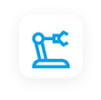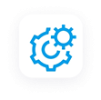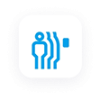Robotics is the science of developing robots. Computer science, technology, and engineering converge in this multidisciplinary field. Robotics professionals focus on designing, developing, and implementing robots in various applications ranging from routine industrial operations to activities in hazardous environments.
However, with the current developments in Artificial Intelligence (AI), Machine Learning (ML), and the Internet of Things (IoT), the horizons of human-robot interactions may extend in the near future. Estimates suggest that the international robotics industry will display a nearly 23% Compound Annual Growth Rate (CAGR) between 2020 and 2030, expected to reach around $215 billion by 2030.
Let's look at some of the top trends in the robotics industry in 2023.
1. Businesses will increasingly adopt Robotics as a Service (RaaS)
Developing and maintaining robots is expensive. As a result, many businesses, particularly small enterprises, fail to incorporate robotics into their operations owing to this limitation. With more enterprises entering the market in 2023 and beyond, the demand for Robotics as a Service, or RaaS, a subscription-based robotics service, will rise. It will help businesses quickly scale their operations according to shifting market conditions.
Research estimates that RaaS installations will grow from 4,442 units to 1.3 million by 2026, generating US$34 billion in revenue for RaaS providers.
2. Cobots will play a critical role in industrial units
The collaboration between robots and humans is increasing day by day. As a result, the demand for Collaborative Robots or Cobots is also rising. These robots are different from standard industrial robots as they have advanced sensors and AI technologies that ensure safer operation around people. Cobots are primarily used in lifting activities and typically come in the form of End-Of-Arm Tooling (EOAT), which automates assembly line tasks like welding and screw drilling.
Cobots enhance worker productivity and safety. However, they also bring down downtimes. In addition, the advent of 5G connectivity and High-Performance Computing (HPC) will aid cobots and improve human-robot collaboration. The global Cobots market is expected to reach US$9.2 billion by 2028, registering a CAGR of 41.5% during the period from 2022 to 2028.
3. Humanoid robots for multiple applications
Direct human contact is declining in the post-pandemic world, increasing the demand for humanoid robots. They are primarily used for tasks like contactless cleaning and delivery. However, they have become an inevitable part of inspecting and maintaining power plants and recovery operations to save humans from disasters.
In addition, they serve as hosts to welcome guests at the front desk. Since humanoid robots automate tasks, they help in reducing business operation expenses and boost industrial production.
4. Assistive robots will provide new capabilities to humans
Physical deformities or disabilities have no place in the future. Thanks to Assistive robots. They are here to improve the quality of life of physically challenged persons as these robots have intelligent sensors powered by AI technology to sense and process every sensory information for human interaction.
The cognitive decision-making capability of these robots helps the elderly, sick or physically challenged, fulfill their Activities of Daily Living (ADL). Furthermore, assistive robotic devices like powered exoskeletons function as patient rehabilitation tools. These wearable mechanical tools restore motor function in disabled patients and ensure the safety of industrial workers.
5. Autonomous Mobile Robots (AMRs) will grow in numbers
Worker safety and smoother business operations would be major objectives for every futuristic enterprise. Autonomous Mobile Robots, or AMRs, will help every business to meet these demands. These robots have advanced sensors, AI, and computer vision to map the surroundings and conduct independent navigation. So, they help workers exposed to hazardous working conditions.
For example, AMRs in a warehouse automate material handling, inspect stocks, and prevent inventory depletion. It can speed up internal logistics operations and free workers from labor-intensive tasks. Moreover, AMRs are highly useful for cleaning, housekeeping, and autonomous disinfection in the hospitality industry. They are also used for contactless and quick Last Mile Delivery (LMD).
6. Internet of Things (IoT) will help leverage robotics data
The Internet of Things (IoT) will act as the backbone of robotics in the future as it carries out connected robots' sensing, monitoring, and tracking functions. These edge computing platforms collect and transmit data, enabling feedback-driven workflows influencing connected robots' performance.
Recent advancements in the IoT sector have allowed robotic professionals to relocate computing closer to the data source. They also enable robotic systems to use real-time data by maximizing their efficiency. The global IoT market is projected to cross $650 billion by 2026 from $300 billion in 2021 at nearly 17% CAGR.
The Significance of Sensor Technology in the Robotics Industry
Every living organism, including humans, uses its senses to collect environmental data. Then, this collected data is processed to make decisions. For example, we will pull our hands away if we touch a hot material. These senses and collected data are essential because they provide important information about our environment and help us survive and thrive.
Like living organisms, robots use their senses to collect data from their environment. However, they do it using sensors enabling them to make decisions like how to move or where to go next.
At Hokuyo, we offer a complete range of industrial sensor products suitable for the factory, logistics, and process automation industries. From safety laser scanners that provide maximum protection for mobile or stationary applications to a laser distance sensor that can carry out long-range distance measurements with millimeter accuracy, our intelligent sensing solutions are ideal for a range of autonomous robotic applications.
Browse our range of sensor products or contact us to learn more about our capabilities.

 Factory Automation
Factory Automation Logistics Automation
Logistics Automation Process Automation
Process Automation Crane Collision Avoidance
Crane Collision Avoidance LiDAR/Obstacle Detection
LiDAR/Obstacle Detection Safety Laser Scanners
Safety Laser Scanners Optical Data Transmission
Optical Data Transmission Hot Metal Detectors
Hot Metal Detectors Laser Distance Sensor
Laser Distance Sensor Blog
Blog Whitepapers
Whitepapers Case Studies
Case Studies Infographics
Infographics